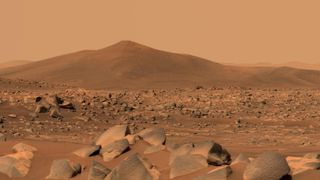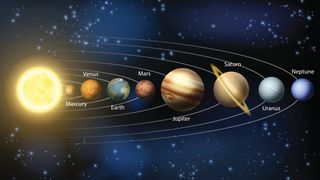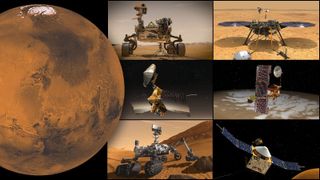Mars: The Red Planet
Mars is the fourth planet from the sun.

Mars, the fourth planet from the sun, is a dry, rocky world whose iconic red color has earned it the nickname the Red Planet. Mars has fascinated people throughout history, and today, it is one of the most explored bodies in the solar system, with many rovers and orbiters searching the planet for evidence of life, past or present.
How did Mars get its name?
Because Mars is visible with the naked eye in Earth's night sky, many ancient civilizations noticed and named it. The ancient Romans named the planet Mars after the Roman god of war, according to NASA, because they associated the planet's blood-red color with conflict and battles.
Similarly, the Babylonians called the Red Planet Nergal, after their god of fire, war and destruction; and early Hindus named it Mangala, after their own god of war, according to a website run by the U.K. National Astronomy Week. The ancient Egyptians called it Her Desher, meaning "the red one," according to NASA.
What is Mars made of?
The Red Planet is rocky, much like Earth. It has a diameter of roughly 4,222 miles (6,794 kilometers) — about half of Earth's diameter, according to the European Space Agency (ESA).
Mars' crust is 6 to 30 miles (10 to 50 km) thick and is composed mainly of iron, magnesium, aluminum, calcium and potassium, according to NASA. Below that is a rocky mantle 770 to 1,170 miles (1,240 to 1,880 km) thick, which surrounds a dense core that's made of iron, nickel and sulfur and has a radius of 930 to 1,300 miles (1,500 to 2,100 km).

Scientists used NASA's Insight lander, which picked up seismic vibrations on the planet, to map Mars' insides in detail. They found that the planet's core was much larger than expected, taking up roughly half of Mars' interior.
Mars' rocky surface is covered in dust, boulders and numerous craters. Such features have fooled many people over the centuries, making them believe they had spotted gigantic face-like structures, tiny humanoids and even hairy blue spiders. These are all tricks of the human imagination, which is geared toward seeing recognizable things, Live Science previously reported.
A thin atmosphere surrounds the Martian surface, which has almost 1,000 times less pressure than the pressure at sea level on Earth, according to Arizona State University. Mars' atmosphere is 95% carbon dioxide, 3% nitrogen, 1.6% argon, and trace amounts of oxygen, carbon monoxide, water, methane and other gases, as well as dust. The light dust is easily blown around the planet by winds, giving the skies a tan color. A probe built by the United Arab Emirates recorded beautiful and enormous auroras wrapping halfway around Mars in 2022.
How far is Mars from the sun?

Mars orbits at an average distance of 142 million miles (228 million km) from the sun, according to NASA. Its orbit is about 1.5 times the size of Earth's. Sunlight takes roughly 13 minutes to get to Mars, while it takes around 8 minutes to reach our planet.
A day on Mars lasts about 24.6 hours, or just a little longer than a day on Earth. Martian days are called sols — short for solar day — and there are 669.6 sols in a Martian year. Mars' axial tilt is also very similar to our planet's, at about 25 degrees (Earth's is 23.4 degrees), meaning Mars experiences seasons much like those on Earth.
How many moons does Mars have?
Mars has two small, potato-shaped moons named Phobos and Deimos, according to NASA. These satellites are named for two sons of the Greek god of war Ares (Latin: Mars), according to Live Science’s sister site, Space.com. The names Phobos and Deimos mean fear and panic, respectively.

The innermost moon, Phobos, is heavily cratered and roughly 13.8 miles (22.2 km) in diameter. In about 50 million years, it is expected to break up or crash into Mars, according to NASA.
Deimos orbits 2.5 times farther from Mars than Phobos does and is half the size — about 7.8 miles (12.6 km) across — according to Cool Cosmos. Both moons are made mostly from rock and iron and may have once been asteroids that got captured by Mars' gravitational pull.
How have humans explored Mars?
The Red Planet has been a target for investigations over many centuries. No planet has been so heavily explored, other than our own, according to NASA.
Starting in the late 1700s, British astronomer William Herschel made some early scientific observations of Mars with a telescope, and he noted that Mars had darker areas, which he believed to be oceans, and lighter regions, which he thought were continents like those on Earth.
In the 19th century, Mars was investigated by Italian astronomer Giovanni Schiaparelli and American astronomer Percival Lowell, who believed they saw long canals on the planet's surface indicating civilizations and life. Their claims were dismissed by others in their time and ultimately turned out to be incorrect.
The first attempts from both the U.S. and the USSR to send probes to Mars during the space race ended in failure, according to ESA. The first probe to succeed was NASA's Mariner 4 probe, which reached the Red Planet on July 15, 1965, flying by it and sending back photos of the planet's surface, according to NASA. While the U.S. managed a few more early triumphs, the Soviet Union's probes mainly failed. Historically, half of all the probes sent to Mars have crashed or died.

NASA's Mariner 9 was the first mission to successfully orbit Mars, according to the agency. Reaching its target in 1971, Mariner 9 studied a large dust storm that engulfed most of the planet. The Viking 1 and 2 landers were the first human-made objects to make it to the Red Planet's surface and survive for more than a few minutes, when they reached the Martian land in 1976, according to The Planetary Society. From the surface, they proceeded to take photos and data readings of their surroundings, as well as conduct the first search for life on the planet.
Though there was a lull in missions afterward, space agencies around the world continued to make attempts at robotic exploration of Mars during the 1980s and 1990s. On July 4, 1997, NASA landed its first probe on Mars in two decades — the Pathfinder lander and its adorable tiny rover, Sojourner, according to The Planetary Society. These were followed by many orbiters and landers, including the twin rovers Opportunity and Spirit, which conducted investigations from 2004 to 2018 and 2019, respectively.
The current suite of robots on Mars includes NASA's Curiosity and Perseverance rovers, both of which have produced incredible scientific findings during their missions. Perseverance carried Ingenuity, the first helicopter to fly on Mars, and it has produced stunning images during its travels. China's Zhurong rover, part of the country's Tianwen-1 mission, successfully landed on Mars in 2021, and it has sent back beautiful pictures and even sounds from the surface.
Many other missions, both past and present, have produced amazing insights about the planet's history, and future planned missions should help continue this progress, according to The Planetary Society. NASA aims to send humans to explore the Red Planet by the late 2030s or early 2040s, according to Space.com.
Is there life on Mars?
NASA scientists believe that life may have once thrived on Mars, as there is ample evidence that the planet used to be much warmer and wetter billions of years ago. Whether there is anything alive today on Mars is an open question.
NASA's Curiosity rover detected methane — a potential indicator of microbial activity — expelled from the ground in the region known as Gale Crater. The probe also spotted intriguing evidence of organic compounds in the Martian soil, though what that means isn't entirely clear.
Is there water on Mars?
The possibility that there were once oceans and rivers on Mars is fairly well established. Observations suggest that there could have been water on the surface as recently as 2 billion years ago.
Nobody knows if much water is still there today. Some probes have spotted signs of dark streaks that appear to flow downhill, but it's still unclear what, exactly, these observations represent. In 2020, scientists thought they spotted evidence of buried lakes of liquid water beneath Mars' south polar ice cap, but later data suggested that these were merely clay deposits that produced bright radar reflections mimicking bodies of water.
Additional resources
- See how NASA is currently exploring Mars, as well as the agency's plans for Mars exploration, on this website dedicated to Martian probes.
- Dive into this stunning map of different regions on the Red Planet, courtesy of the U.S. Geological Survey.
- Browse even more amazing images from NASA's Mars missions on the agency's multimedia page.
Sign up for the Live Science daily newsletter now
Get the world’s most fascinating discoveries delivered straight to your inbox.

Adam Mann is a freelance journalist with over a decade of experience, specializing in astronomy and physics stories. He has a bachelor's degree in astrophysics from UC Berkeley. His work has appeared in the New Yorker, New York Times, National Geographic, Wall Street Journal, Wired, Nature, Science, and many other places. He lives in Oakland, California, where he enjoys riding his bike.
